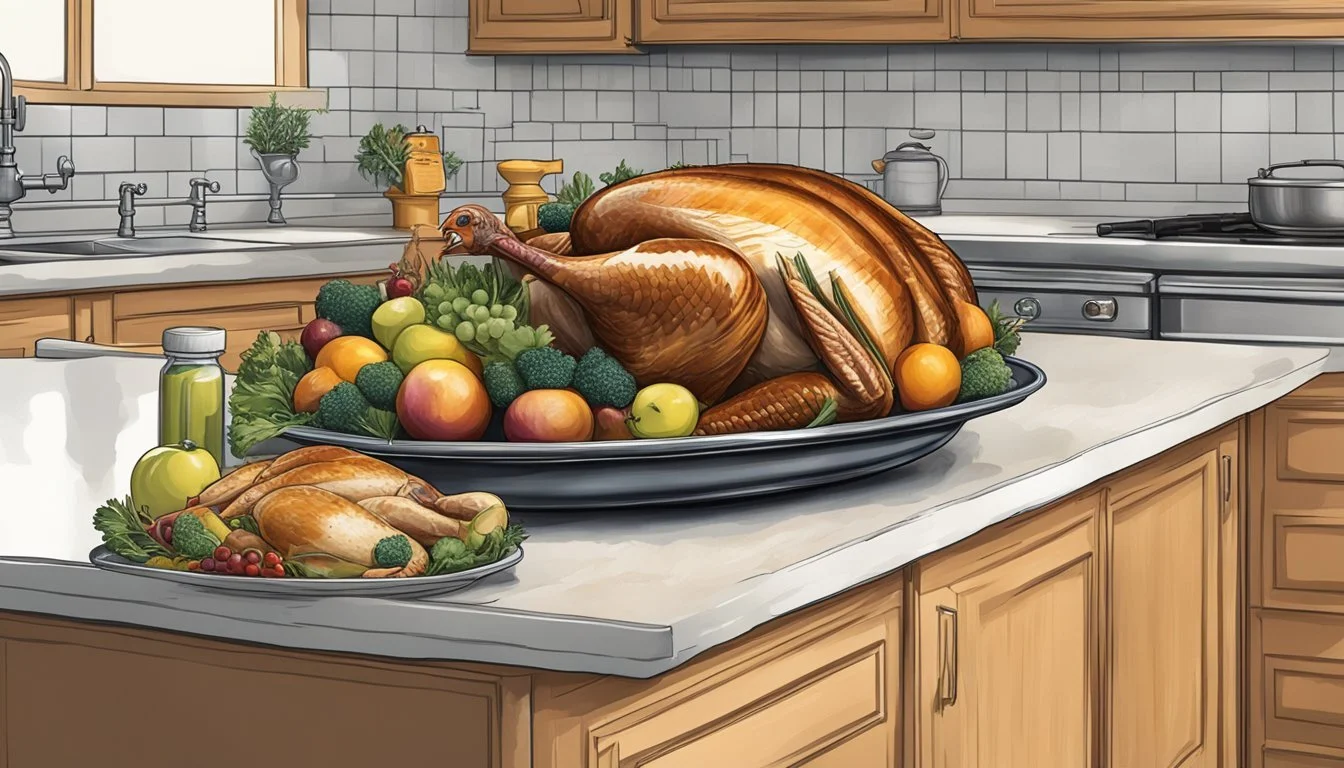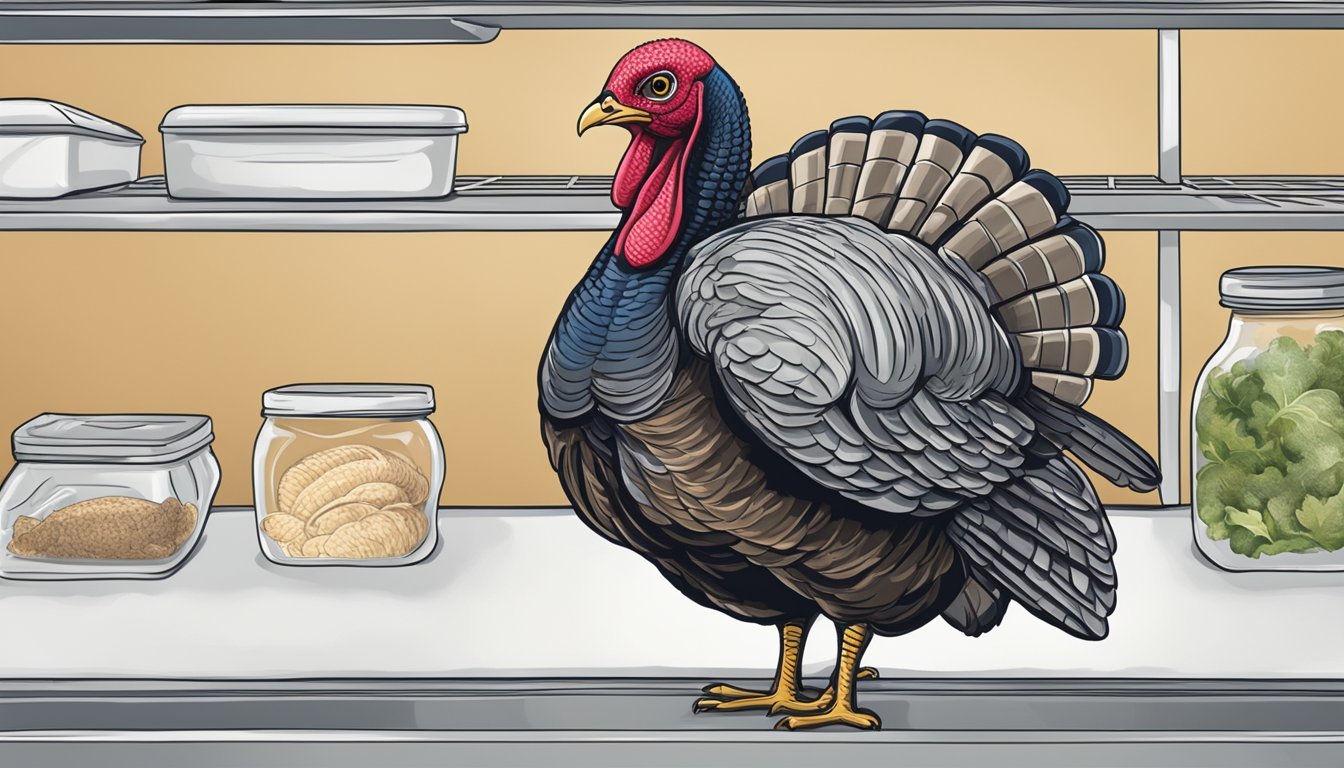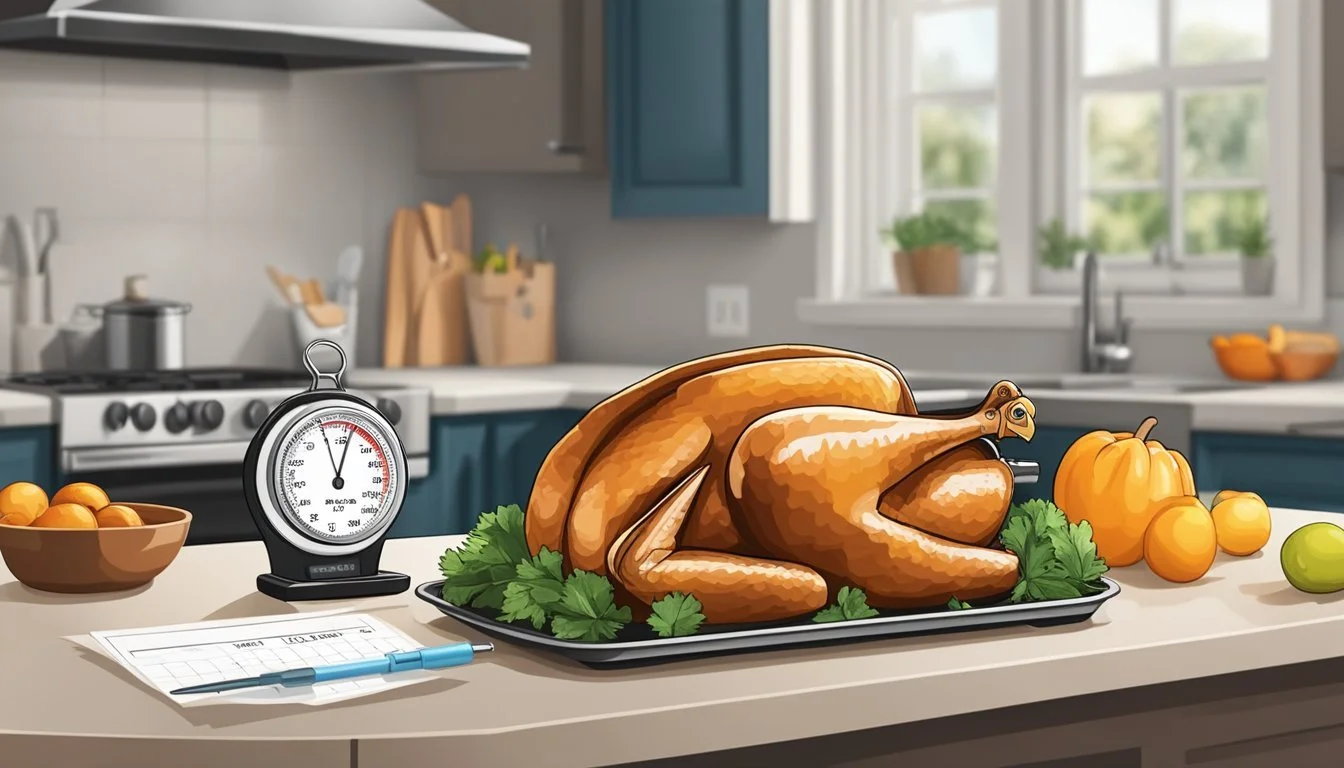How Long Does Turkey Last?
Shelf Life and Storage Tips
Understanding the proper storage and shelf life of turkey is crucial for both safety and quality. Turkey (What wine goes well with turkey?) is a popular poultry choice, especially during holiday seasons, but once the feast is over, the question of how long leftovers can be safely consumed arises. The longevity of both cooked and uncooked turkey depends on how the bird is stored. Refrigeration at 40°F or lower is essential to slow down bacterial growth and ensure that turkey remains safe for consumption.
Cooked turkey should be eaten within 3 to 4 days when stored in the refrigerator. This timeline helps to prevent foodborne illness, as the risk of bacterial contamination increases after this period. Freezing the turkey can extend its life. Properly stored, frozen cooked turkey keeps its best quality for 3 to 4 months. Though safe indefinitely in the freezer, over time, frozen turkey may experience a decrease in moisture and flavor.
When it comes to raw turkey, it has a shorter refrigerator shelf life and should be cooked within 1 to 2 days of purchasing. Always ensure it is stored securely to prevent raw juices from contaminating other foods. For those who plan ahead, a frozen turkey can be kept for longer periods before cooking—up to a year for a whole turkey or 9 to 12 months for turkey pieces, ensuring holiday plans or impromptu gatherings can include a delicious turkey meal without the rush of last-minute shopping.
Turkey Storage Fundamentals
Proper turkey storage is crucial for maintaining food safety and quality. Whether refrigerating or freezing, one must adhere to specific guidelines to ensure the turkey remains safe to consume and retains its flavor.
Refrigerating Turkey
Refrigerated turkey should be kept at a consistent temperature of 40 degrees Fahrenheit or below to prevent bacterial growth. Cooked turkey leftovers, when stored properly in the fridge in an airtight container, will last for up to 4 days.
Uncooked turkey: Store it in the refrigerator for 1-2 days past the sell-by date.
Cooked turkey leftovers: Include them in meals within 4 days.
Deli turkey: Consume within 5-6 days for best quality.
Freshness can be maximized by minimizing the time the turkey spends in the "Danger Zone," which is between 40 and 140 degrees Fahrenheit.
Freezing Turkey
Freezing turkey is an effective method to extend its shelf life while preserving its taste and nutritional value. To freeze turkey, one should:
Wrap the turkey: Use moisture-resistant wrapping or an airtight container to protect against freezer burn.
Cooked turkey leftovers: For best quality, consume within 6 months when frozen.
Uncooked turkey: Utilize within one year for optimal quality.
Freezing temperature: Maintain a consistent 0 degrees Fahrenheit to ensure safety.
All turkey, once frozen, is safe indefinitely, but its quality diminishes over time, so adhering to these timelines is recommended for best results.
Determining Turkey Shelf Life
Understanding the shelf life of turkey is crucial for maintaining food safety and optimizing freshness. Factors such as storage temperature and the state of the turkey—either cooked or uncooked—greatly influence its longevity.
In The Fridge
For cooked turkey, it is advised to consume it within four days of refrigeration to ensure safety and quality. The refrigerator must maintain a steady temperature at or below 40°F (4°C) to protect against bacterial growth. If there is a plan to consume the turkey, it should be done within this timeframe. Fresh turkey that has not been cooked ought to be stored similarly, with a recommendation of cooking it within 1-2 days of purchase.
In The Freezer
Frozen turkey has a significantly longer shelf life. A whole, uncooked turkey can be kept in the freezer for up to a year while maintaining quality, although some sources suggest best quality is retained for 6-8 months. Cooked turkey should ideally be consumed within six months when frozen to enjoy its best quality. It is paramount to freeze the turkey at 0°F (-18°C) immediately if it is not planned to be eaten within the advisable refrigerated time period to preserve its safety and taste.
Signs of Turkey Spoilage
When assessing whether turkey has gone bad, one should look for clear signs of spoilage such as changes in color, texture, and smell. These indicators are reliable measures to ensure the turkey is safe to eat.
Visual Cues
The color of fresh turkey should have a consistent appearance without any discoloration or dullness. Signs of spoilage include:
Darkened areas may indicate mold or bacterial growth.
Grayish hues on cooked turkey suggest deterioration.
Texture and Smell
The texture of turkey is crucial for determining if it is still safe to consume. In contrast, the smell of turkey can be an immediate indicator of spoilage:
Slimy texture: Turkey should not feel slippery or gooey. A slimy texture is a sign of bacterial growth.
Bad smell: A sour or ammonia-like odor is a clear sign that the turkey has gone bad and should not be consumed.
Health and Safety Considerations
When handling turkey, individuals must prioritize maintaining food safety to prevent foodborne illness. The USDA has set forth guidelines to ensure that turkey is stored and cooked to safe temperatures. To prevent bacterial growth, a fresh turkey should be stored at 40°F or lower and used within 1 to 2 days. For frozen turkey, proper thawing is critical: approximately 24 hours for every four to five pounds in the refrigerator is required for safe defrosting.
Thawing and Cooking:
Refrigerator: 24 hrs/4-5 lbs of turkey
Cold water: Submerged, water changed every 30 minutes
Cooking: Internal temperature of 165°F
Proper hygiene while preparing turkey is crucial in avoiding contamination. Hands, utensils, and surfaces should be washed thoroughly after contact with raw turkey. Cooking the turkey to an internal temperature of 165°F ensures the elimination of harmful bacteria. This temperature must be checked at the breast, thigh, and wing joints of the turkey.
Internally Checking Temperature:
Breast: Thickest part
Thigh: Where body and thigh join
Wing: Where body and wing join
Leftovers should be refrigerated within two hours of cooking and consumed within three to four days. If freezing leftovers, they should be used within six months for optimal quality.
Leftovers Handling:
Refrigerator: Use within 3-4 days
Freezer: Best used within 6 months
Adhering to these health considerations not only prevents foodborne illnesses but also ensures the turkey remains a delicious and safe centerpiece to any meal.
Maximizing Turkey Quality
To ensure turkey retains its quality, both temperature control and proper packaging are essential. These factors play a crucial role in preserving the taste, texture, and overall quality of turkey.
Temperature and Time
The temperature at which turkey is stored critically impacts its quality. Refrigerated raw turkey should be kept at or below 40°F and consumed within two days to prevent bacterial growth. Cooked turkey holds its quality for 3 to 4 days in the fridge. If frozen, turkey should be kept at 0°F and can remain at peak quality for 6-8 months; beyond this period, it is safe to eat but may suffer from freezer burn affecting taste and texture.
Packaging Techniques
Proper packaging keeps turkey fresher for longer, retaining its seasoning and moisture. For the fridge, use airtight containers or sealed plastic bags. For the freezer, wrap the turkey in aluminum foil or freezer paper and then place in a freezer bag to protect against freezer burn and maintain its texture. Deli turkey benefits from being tightly sealed and ideally vacuum packed, lasting about 5-6 days.
Turkey Consumption Ideas
When it comes to utilizing leftover turkey, one has a wealth of options to rejuvenate this classic protein. From transforming it into exciting new dishes to incorporating it into comforting traditional recipes, leftover turkey offers versatility and flavor.
Creative Leftover Recipes
Sandwiches: The quintessential day-after-Thanksgiving sandwich is both a delight and a practical way to use leftover turkey. Layer slices of turkey with cranberry sauce, stuffing, and a smear of mayonnaise between two slices of bread for a satisfying meal.
Turkey Tetrazzini: An American classic, Turkey Tetrazzini combines leftover turkey with pasta, mushrooms, and a creamy sauce, baked to golden perfection under a blanket of Parmesan cheese and breadcrumbs.
Serving Suggestions
Salad: Add bite-sized pieces of turkey to a fresh salad for a protein boost. Toss together mixed greens, cherry tomatoes, cucumbers, and any additional preferred vegetables with a light vinaigrette for a refreshing meal.
Soup: With cooler weather often accompanying turkey season, a hearty soup is an excellent way to utilize leftovers. One can incorporate turkey into a vegetable or noodle soup, adding richness and heartiness to a warm, comforting bowl.
Proper Handling and Preparation
Proper handling and preparation of turkey is crucial for safety and quality. The following procedures ensure that turkey remains fresh and safe to eat from thawing to serving.
Thawing Frozen Turkey
To safely thaw frozen turkey, allow 1 day for every 4-5 pounds of weight. Thawing in the fridge is recommended, as it keeps the turkey below 40°F, inhibiting bacterial growth. If short on time, one may thaw the turkey in cold water, changing the water every 30 minutes to maintain the cold temperature. The National Turkey Federation advises against thawing turkey on the counter as it can enter the danger zone of temperatures where bacteria multiply rapidly.
Preventing Contamination
Maintaining hygiene during turkey preparation is essential to prevent foodborne illnesses. Always wash hands before and after handling turkey. Use separate cutting boards, plates, and utensils for raw turkey to avoid cross-contamination with other foods. Cook turkey to an internal temperature of 165°F, checked with a food thermometer in the thickest part of the breast, thigh, and wing join. Leftover turkey should be refrigerated within 2 hours of cooking and can remain refrigerated for 1-2 days; it’s also safe to freeze leftover turkey to extend its shelf life.
Extending Turkey's Edibility
To ensure turkey retains its quality and remains safe to consume, incorporating preservatives and maintaining optimal storage conditions are critical measures.
Using Preservatives
Preservatives can play a pivotal role in extending the shelf life of turkey. When considering meat preservation, one might opt for natural preservatives like salt or vinegar, which can help deter bacteria growth and reduce the potential for spoilage. It is essential to use these additives in moderation and following proper guidelines to maintain the meat's edibility and flavor profile.
Optimal Storage Conditions
The refrigerator remains the go-to method for prolonging the edibility of turkey. To store turkey efficiently and extend its shelf life, one should:
Maintain a consistent refrigerator temperature of 40 degrees Fahrenheit or below to inhibit bacterial activity.
Wrap the turkey properly, using airtight packaging or containers to minimize exposure to air and prevent the turkey from losing moisture.
Place the turkey in the coldest part of the refrigerator, usually at the back of the lower shelf.
Monitor the sensory qualities of the meat—its color, smell, and texture—to ensure it has not degraded.
By following these guidelines, the refrigerated turkey can maintain its quality over an extended period, typically up to 4 days for cooked turkey, as advised by food safety experts. Raw turkey should ideally be cooked or frozen within 1 to 2 days after purchase to preserve its quality.
Additional Tips and Tricks
When storing turkey, one should be mindful that room temperature can affect its freshness. Turkey should never be left out at room temperature for more than two hours, as bacteria grow rapidly between 40°F and 140°F. If the turkey is intended for leftovers or future use, it ought to be refrigerated promptly.
Maintaining good stock rotation is paramount. One should label their turkey with the date it was stored. First in, first out (FIFO) method could be implemented to ensure older stock is used before fresher stock.
Incorporating flavors like thyme can enhance turkey dishes. However, when storing turkey with herbs, it is essential to store separately to preserve the original flavor of the turkey and prevent the herbs from wilting or becoming soggy.
For those who prepare their turkey with accompaniments like potatoes, when storing leftovers, it is advisable to keep the turkey separate from side dishes to maintain the integrity and taste of each component. Potatoes, for instance, may retain moisture that can affect the turkey’s texture.
Turkey Storage Guidelines:
Fridge (cooked): 3-4 days
Freezer (cooked): 2-6 months
Fridge (raw): 1-2 days
Using the proper storage techniques not only keeps turkey safe for consumption but can also preserve its best quality, whether it's seasoned or prepared with accompaniments.








